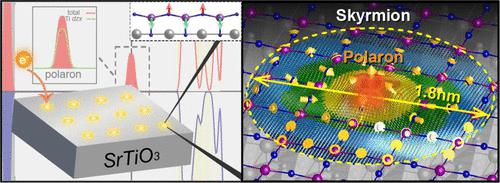Our official English website, www.x-mol.net, welcomes your
feedback! (Note: you will need to create a separate account there.)
Ultrasmall Polar Skyrmions and Merons in SrTiO3 Heterostructures by Polaron Engineering
ACS Nano ( IF 15.8 ) Pub Date : 2023-05-31 , DOI: 10.1021/acsnano.3c02481 Tao Xu 1 , Yuuki Ichiki 1 , Kairi Masuda 1 , Yu Wang 1 , Hiroyuki Hirakata 1 , Takahiro Shimada 1
ACS Nano ( IF 15.8 ) Pub Date : 2023-05-31 , DOI: 10.1021/acsnano.3c02481 Tao Xu 1 , Yuuki Ichiki 1 , Kairi Masuda 1 , Yu Wang 1 , Hiroyuki Hirakata 1 , Takahiro Shimada 1
Affiliation

|
Topological objects with skyrmionic textures in ferroelectrics, i.e., polar skyrmions, are promising technological paradigms in next-generation electronic devices. While breakthrough discoveries of stable polar skyrmions approximately ten nanometers in size have been very recently witnessed in complex systems, such a nontrivial topological order in ferroelectrics inevitably disappears below the ferroelectric critical size of several nanometers. Herein, we propose a strategy to overcome this limitation and achieve ultrasmall and isolated polar skyrmions by engineering excess-electron polarons in otherwise nonferroelectric SrTiO3 heterostructures. Our first-principle calculations demonstrate that a polaron localized at a SrTiO3 surface induces a Neel-type polar skyrmion as small as 1.8 nanometers attributed to the effect of atomic-scale surface roughness. Furthermore, we show that this polar topological structure is tunable by the choice of heterostructures and by the mechanical approach, which undergoes a phase transition to a meron state in the twisted boundary and to an antiskyrmion state in the surface with external shear strain, respectively. Such ultraminiaturization of skyrmions and their transitions unexpectedly unravels the formula of ultrasmall topological orders originating from the interplay between an electron polaron and structural symmetry breaking, which is completely different from the common mechanism of geometric confinement for larger-scale skyrmions. Our results not only provide a mechanism for the exploration of polar skyrmions and their rich topological transitions but also hold potential for ultrahigh-density memories.
中文翻译:

Polaron Engineering 的 SrTiO3 异质结构中的超小型极地 Skyrmions 和 Merons
铁电体中具有 skyrmion 纹理的拓扑物体,即极性 skyrmions,是下一代电子设备中有前途的技术范例。虽然最近在复杂系统中发现了尺寸约为 10 纳米的稳定极性斯格明子的突破性发现,但铁电体中这种非平凡的拓扑序不可避免地会在几纳米的铁电临界尺寸以下消失。在此,我们提出了一种策略来克服这一限制,并通过在其他非铁电 SrTiO 3异质结构中设计过剩电子极化子来实现超小和孤立的极地斯格格子。我们的第一性原理计算表明极化子位于 SrTiO 3由于原子级表面粗糙度的影响,表面诱导小至 1.8 纳米的尼尔型极地斯格明子。此外,我们表明这种极性拓扑结构可以通过异质结构的选择和机械方法进行调节,其分别在扭曲边界中经历相变到 meron 状态,在具有外部剪切应变的表面中经历相变到 antiskyrmion 状态。斯格明子的这种超小型化及其跃迁出人意料地揭示了源自电子极化子与结构对称性破缺之间相互作用的超小拓扑序的公式,这与大规模斯格明子的几何限制的常见机制完全不同。
更新日期:2023-05-31
中文翻译:

Polaron Engineering 的 SrTiO3 异质结构中的超小型极地 Skyrmions 和 Merons
铁电体中具有 skyrmion 纹理的拓扑物体,即极性 skyrmions,是下一代电子设备中有前途的技术范例。虽然最近在复杂系统中发现了尺寸约为 10 纳米的稳定极性斯格明子的突破性发现,但铁电体中这种非平凡的拓扑序不可避免地会在几纳米的铁电临界尺寸以下消失。在此,我们提出了一种策略来克服这一限制,并通过在其他非铁电 SrTiO 3异质结构中设计过剩电子极化子来实现超小和孤立的极地斯格格子。我们的第一性原理计算表明极化子位于 SrTiO 3由于原子级表面粗糙度的影响,表面诱导小至 1.8 纳米的尼尔型极地斯格明子。此外,我们表明这种极性拓扑结构可以通过异质结构的选择和机械方法进行调节,其分别在扭曲边界中经历相变到 meron 状态,在具有外部剪切应变的表面中经历相变到 antiskyrmion 状态。斯格明子的这种超小型化及其跃迁出人意料地揭示了源自电子极化子与结构对称性破缺之间相互作用的超小拓扑序的公式,这与大规模斯格明子的几何限制的常见机制完全不同。

































 京公网安备 11010802027423号
京公网安备 11010802027423号